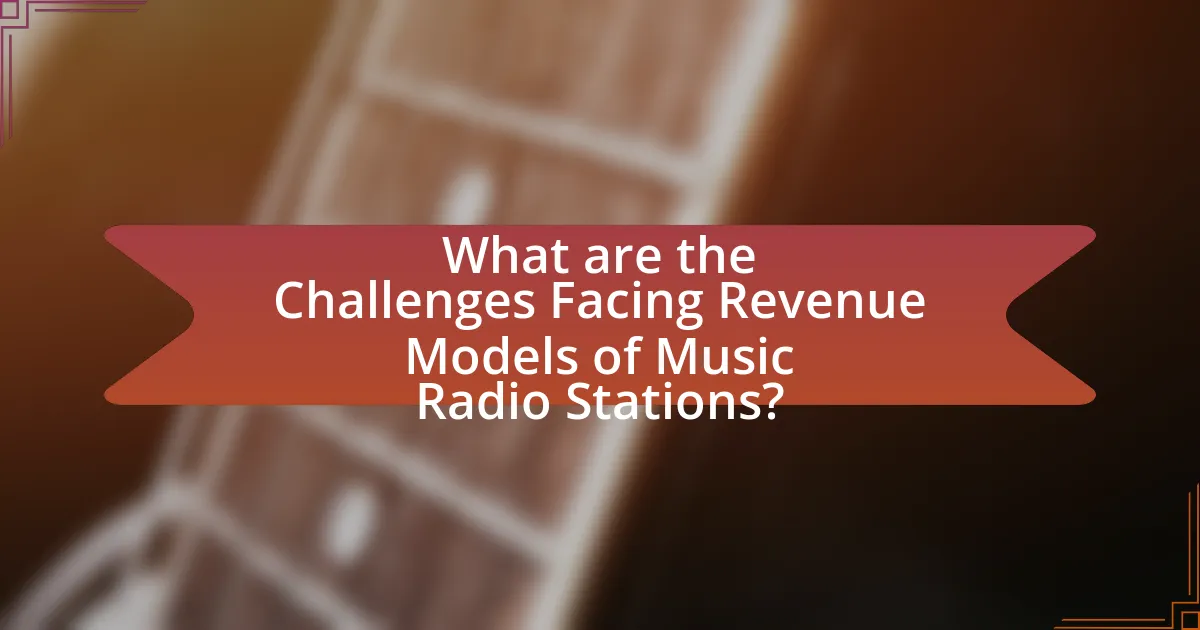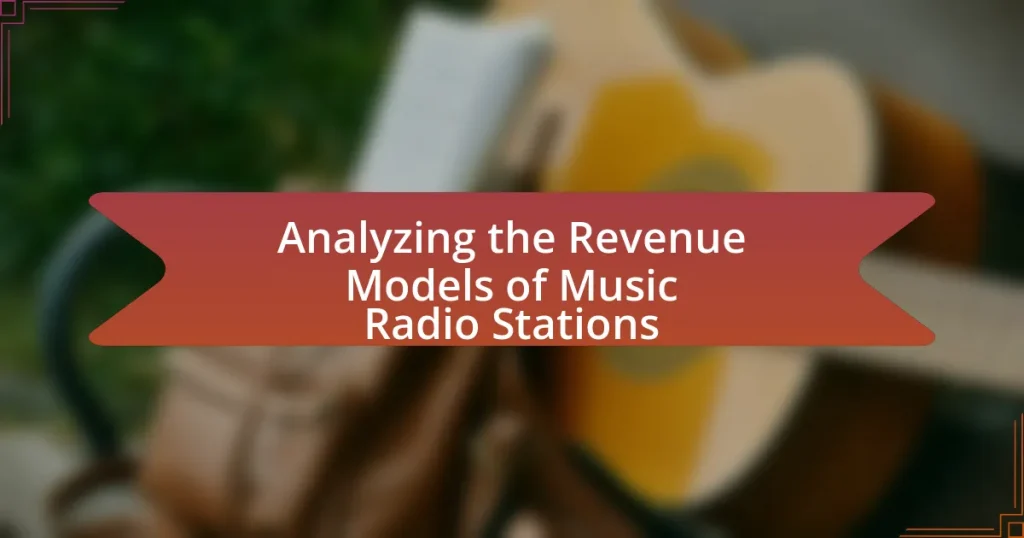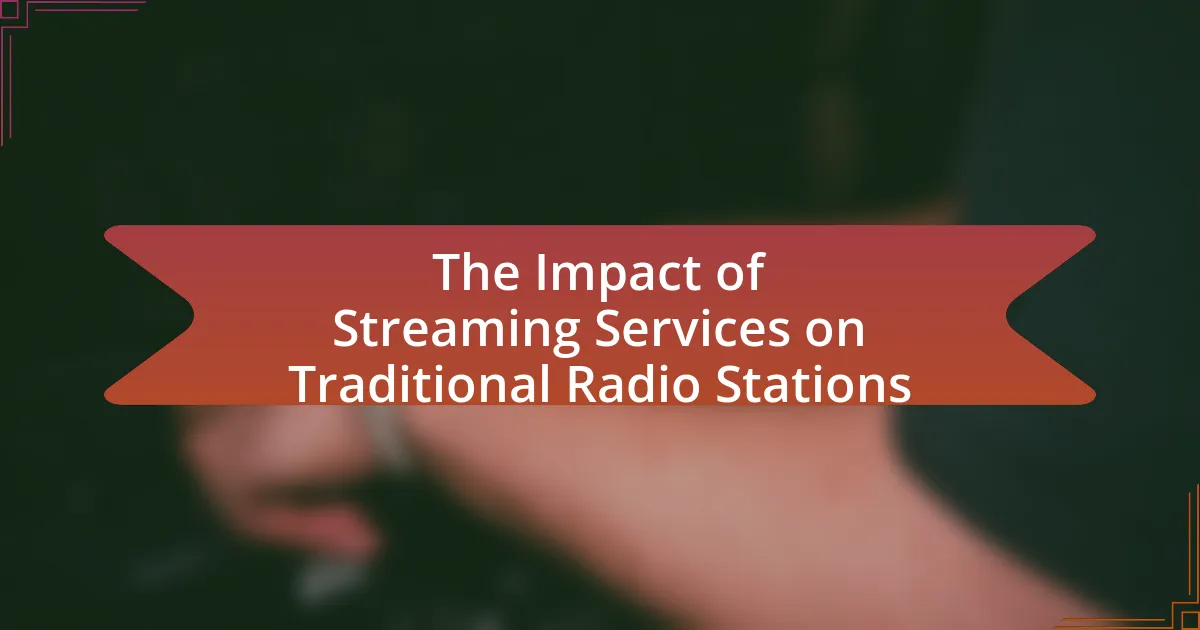The article analyzes the revenue models of music radio stations, highlighting key sources of income such as advertising, sponsorships, listener donations, and merchandise sales. It emphasizes the dominance of advertising revenue, which accounted for approximately $14.5 billion in the U.S. in 2022, and discusses the impact of listener engagement on revenue generation. Additionally, the article addresses challenges faced by radio stations, including competition from digital platforms and changing consumer behaviors, while exploring innovative strategies for revenue growth, such as digital advertising and subscription services. The implications of regulatory compliance and economic factors on profitability are also examined, providing a comprehensive overview of the evolving landscape of music radio station revenues.

What are the Revenue Models of Music Radio Stations?
Music radio stations primarily generate revenue through advertising, sponsorships, listener donations, and merchandise sales. Advertising constitutes the largest portion of revenue, with stations selling airtime to businesses that want to promote their products or services. According to the Radio Advertising Bureau, U.S. radio advertising revenue reached approximately $14.3 billion in 2020, highlighting the significance of this model. Sponsorships involve partnerships with brands that may sponsor specific shows or segments, providing additional financial support. Listener donations, particularly for public or community radio stations, can also contribute to revenue, as these stations often rely on their audience for funding. Lastly, merchandise sales, including branded items, can provide supplementary income for music radio stations.
How do music radio stations generate income?
Music radio stations generate income primarily through advertising revenue. Advertisers pay radio stations to air commercials during programming, capitalizing on the audience reach of the station. According to the Radio Advertising Bureau, in 2022, radio advertising revenue in the United States was approximately $14.5 billion, demonstrating the significant financial impact of advertising on radio station income. Additionally, some stations may also earn income through sponsorships, events, and merchandise sales, but advertising remains the dominant source of revenue.
What are the primary sources of revenue for music radio stations?
The primary sources of revenue for music radio stations are advertising, sponsorships, and listener donations. Advertising constitutes the largest portion of revenue, with stations selling airtime to businesses seeking to promote their products or services. According to the Radio Advertising Bureau, radio advertising revenue in the United States reached approximately $14.4 billion in 2020, highlighting the significance of this revenue stream. Sponsorships involve partnerships with brands that may sponsor specific programs or events, providing additional financial support. Listener donations, particularly for public or non-profit radio stations, contribute to funding through listener-supported models, where audiences are encouraged to contribute financially to sustain operations. These three revenue sources collectively enable music radio stations to operate and thrive in a competitive media landscape.
How do advertising and sponsorships contribute to revenue?
Advertising and sponsorships significantly contribute to revenue for music radio stations by providing a primary source of income through paid promotions and brand partnerships. Radio stations sell advertising slots during programming, allowing businesses to reach a targeted audience, which generates substantial revenue; for instance, in 2022, U.S. radio advertising revenue was approximately $14.5 billion. Sponsorships further enhance this revenue stream by allowing brands to associate themselves with specific shows or events, often resulting in long-term contracts that secure consistent funding. This dual approach of leveraging both advertising and sponsorships enables radio stations to maintain financial stability and invest in content creation, thereby reinforcing their market presence.
What role does listener engagement play in revenue generation?
Listener engagement is crucial for revenue generation in music radio stations as it directly influences advertising effectiveness and listener loyalty. High levels of engagement lead to increased audience retention, which attracts advertisers seeking to reach a dedicated listener base. According to a Nielsen study, engaged listeners are 50% more likely to recall advertisements, enhancing the value of ad placements. Additionally, engaged audiences are more likely to participate in promotions and contests, further driving revenue through sponsorships and partnerships. Thus, listener engagement not only boosts advertising revenue but also fosters a sustainable listener community that supports ongoing financial growth for radio stations.
How does audience size impact advertising rates?
Audience size directly influences advertising rates, as larger audiences typically command higher rates due to increased exposure potential. Advertisers are willing to pay more for access to a broader listener base, which enhances the likelihood of reaching their target demographics. For instance, a radio station with a weekly audience of 100,000 listeners may charge significantly more per advertisement than a station with only 10,000 listeners, reflecting the greater opportunity for brand visibility and engagement. This correlation is supported by industry data indicating that advertising rates can increase by as much as 50% or more for stations that double their audience size, demonstrating the financial impact of audience reach on advertising pricing.
What strategies do stations use to increase listener loyalty?
Stations increase listener loyalty through targeted programming, community engagement, and listener interaction. Targeted programming involves curating content that resonates with the audience’s preferences, such as specific music genres or themes, which can lead to higher listener retention. Community engagement strategies, like hosting local events or partnering with local businesses, foster a sense of belonging among listeners. Additionally, stations utilize listener interaction techniques, such as contests, social media engagement, and call-in segments, to create a two-way communication channel that enhances listener investment in the station. Research indicates that stations employing these strategies see a measurable increase in listener loyalty, as evidenced by listener surveys and ratings data.
How do digital platforms influence revenue models?
Digital platforms significantly influence revenue models by enabling diverse monetization strategies such as subscription services, advertising, and content distribution. For instance, platforms like Spotify and Apple Music utilize subscription-based models, allowing users to access vast music libraries for a monthly fee, which generates consistent revenue. Additionally, digital platforms facilitate targeted advertising, where data analytics enable radio stations to deliver personalized ads to specific demographics, increasing ad effectiveness and revenue. According to a report by PwC, the global music streaming market is projected to reach $23 billion by 2023, highlighting the financial impact of digital platforms on revenue models in the music industry.
What are the differences between traditional and online revenue models?
Traditional revenue models primarily rely on advertising, sponsorships, and listener donations, while online revenue models often incorporate digital advertising, subscription services, and merchandise sales. Traditional models depend on physical presence and local markets, with radio stations generating income through local businesses and events. In contrast, online models leverage global reach, allowing for diverse revenue streams such as pay-per-click advertising and streaming subscriptions. For instance, a study by the Pew Research Center in 2021 indicated that 63% of online radio stations utilize subscription services, highlighting a significant shift from traditional advertising reliance.
How do streaming services affect music radio station revenues?
Streaming services negatively impact music radio station revenues by diverting listeners away from traditional radio platforms. As more consumers opt for on-demand streaming options, radio stations experience a decline in audience size, which directly affects their advertising revenue. For instance, a report from the Nielsen Audio indicated that radio listenership dropped by approximately 10% between 2015 and 2020, coinciding with the rise of popular streaming services like Spotify and Apple Music. This shift results in fewer ad spots being sold and lower overall revenue for radio stations, as advertisers increasingly allocate budgets to digital platforms that offer targeted advertising opportunities.

What are the Challenges Facing Revenue Models of Music Radio Stations?
The challenges facing revenue models of music radio stations include declining advertising revenues, increased competition from digital platforms, and changing listener habits. Advertising revenues have decreased as advertisers shift budgets to digital channels, which offer more targeted advertising options. Additionally, music radio stations face competition from streaming services like Spotify and Apple Music, which provide on-demand content and personalized experiences. Changing listener habits, particularly among younger demographics who prefer digital media, further complicate the revenue landscape for traditional radio. According to a 2022 Nielsen report, radio’s share of total audio consumption has dropped to 36%, highlighting the urgency for radio stations to adapt their revenue models to remain viable.
How do economic factors impact revenue generation?
Economic factors significantly impact revenue generation by influencing consumer spending, advertising budgets, and operational costs. For instance, during economic downturns, consumers tend to reduce discretionary spending, which can lead to lower advertising revenues for music radio stations as businesses cut back on marketing expenses. Additionally, inflation can increase operational costs, such as salaries and equipment, further squeezing profit margins. According to a report by the Pew Research Center, advertising revenue for radio stations dropped by 20% during the 2008 financial crisis, illustrating the direct correlation between economic conditions and revenue generation in the industry.
What effects do recessions have on advertising budgets for radio stations?
Recessions typically lead to significant reductions in advertising budgets for radio stations. During economic downturns, businesses often cut marketing expenditures to conserve cash, resulting in decreased ad spending across various media, including radio. For instance, a study by the Pew Research Center in 2020 indicated that advertising revenue for radio stations dropped by approximately 20% during the last recession, reflecting a broader trend where companies prioritize essential expenditures over advertising. This contraction in budgets can severely impact radio stations’ revenue streams, forcing them to adapt their business models to survive in a challenging economic environment.
How do changes in consumer behavior affect revenue streams?
Changes in consumer behavior significantly impact revenue streams by altering how audiences engage with music radio stations. For instance, a shift towards digital streaming platforms has led to decreased traditional radio listenership, resulting in lower advertising revenues for stations reliant on conventional broadcasting. According to a Nielsen report, in 2020, 63% of U.S. adults reported using streaming services, which indicates a substantial preference shift that directly affects radio ad sales. Additionally, changes in consumer preferences for personalized content can lead to increased demand for subscription-based models, prompting radio stations to explore alternative revenue sources such as premium content offerings. This evolution in consumer behavior necessitates that radio stations adapt their revenue strategies to maintain financial viability.
What regulatory challenges do music radio stations face?
Music radio stations face regulatory challenges primarily related to licensing and copyright compliance. These stations must obtain licenses from performance rights organizations to legally broadcast music, which involves navigating complex regulations that vary by country. For instance, in the United States, the Federal Communications Commission (FCC) regulates broadcasting licenses, while organizations like ASCAP and BMI manage performance rights. Failure to comply with these regulations can result in hefty fines and legal repercussions, as evidenced by cases where stations have faced lawsuits for unlicensed music use. Additionally, changes in regulations, such as those concerning digital streaming and advertising, further complicate the operational landscape for music radio stations.
How do licensing fees impact profitability?
Licensing fees significantly reduce profitability for music radio stations by increasing operational costs. These fees are mandatory payments made to rights holders for the use of copyrighted music, which can consume a substantial portion of a station’s revenue. For instance, a report from the Radio Advertising Bureau indicates that licensing fees can account for up to 30% of a station’s total expenses. Consequently, higher licensing fees directly diminish the net income available for reinvestment or distribution to stakeholders, thereby impacting overall profitability.
What are the implications of FCC regulations on revenue models?
FCC regulations significantly impact revenue models for music radio stations by imposing restrictions on advertising content, sponsorships, and licensing fees. These regulations dictate what can be broadcasted, influencing the types of advertisements that can be aired and potentially limiting revenue from certain sponsors. For instance, the FCC enforces rules regarding indecency and obscenity, which can restrict advertising from specific industries, thereby affecting overall revenue streams. Additionally, compliance with licensing requirements, such as paying performance royalties to music rights organizations, adds to operational costs, further influencing the financial viability of revenue models. The interplay between regulatory compliance and revenue generation necessitates that radio stations adapt their business strategies to align with FCC mandates while maximizing their income potential.
How does competition from other media affect revenue?
Competition from other media significantly reduces revenue for music radio stations. As audiences increasingly turn to digital platforms, streaming services, and social media for music consumption, traditional radio faces declining listenership. For instance, a report by Nielsen in 2020 indicated that radio’s share of total audio consumption dropped to 36%, while streaming services accounted for 80% of music revenue growth. This shift leads to advertisers reallocating budgets to platforms with higher engagement, further diminishing radio’s advertising revenue. Consequently, the competitive landscape directly impacts the financial viability of music radio stations.
What strategies can music radio stations employ to remain competitive?
Music radio stations can remain competitive by diversifying their content offerings and enhancing listener engagement through digital platforms. By incorporating podcasts, live streaming, and interactive social media elements, stations can attract a broader audience and retain existing listeners. For instance, according to a 2022 Nielsen report, 62% of radio listeners also engage with digital content, indicating a significant opportunity for stations to expand their reach. Additionally, leveraging data analytics to understand listener preferences allows stations to tailor their programming, thereby increasing listener loyalty and advertising revenue.
How do social media and podcasts challenge traditional radio revenue?
Social media and podcasts challenge traditional radio revenue by diverting audience attention and advertising dollars away from radio platforms. As of 2023, social media platforms like Facebook and Instagram have billions of active users, allowing advertisers to target specific demographics more effectively than traditional radio can. Additionally, the podcasting industry has seen exponential growth, with over 50% of the U.S. population listening to podcasts, which offers advertisers a more engaged audience. This shift in consumer behavior results in decreased listenership for traditional radio, leading to a decline in ad revenue, as advertisers increasingly allocate budgets to digital platforms that provide measurable engagement and targeted reach.

What Innovations are Shaping the Future of Revenue Models for Music Radio Stations?
Innovations shaping the future of revenue models for music radio stations include the integration of digital streaming services, targeted advertising through data analytics, and subscription-based models. Digital streaming services, such as Spotify and Apple Music, have prompted radio stations to adapt by offering online streaming and on-demand content, which attracts a broader audience and generates additional advertising revenue. Targeted advertising, enabled by data analytics, allows stations to deliver personalized ads based on listener preferences, increasing ad effectiveness and revenue potential. Subscription-based models, where listeners pay for ad-free experiences or exclusive content, are also emerging as a viable revenue stream, reflecting a shift in consumer behavior towards premium content access. These innovations collectively enhance revenue opportunities and align radio stations with evolving listener habits.
How are technology advancements influencing revenue generation?
Technology advancements are significantly influencing revenue generation by enabling more efficient advertising strategies and enhancing audience engagement. For instance, digital platforms allow music radio stations to utilize targeted advertising based on listener data, which can increase ad effectiveness and revenue. According to a report by eMarketer, digital ad spending in the U.S. is projected to reach over $200 billion by 2023, highlighting the shift towards digital revenue streams. Additionally, advancements in streaming technology have expanded the reach of radio stations, allowing them to attract a global audience and generate revenue through subscriptions and partnerships. This shift is evidenced by the rise of platforms like Spotify and Apple Music, which have transformed traditional revenue models in the music industry.
What role does data analytics play in optimizing advertising strategies?
Data analytics plays a crucial role in optimizing advertising strategies by enabling targeted marketing and enhancing campaign effectiveness. By analyzing listener demographics, preferences, and behaviors, radio stations can tailor their advertising content to specific audience segments, increasing engagement and conversion rates. For instance, a study by Nielsen found that targeted ads can lead to a 30% increase in listener recall compared to generic ads. Furthermore, data analytics allows for real-time performance tracking, enabling advertisers to adjust their strategies based on immediate feedback, thus maximizing return on investment.
How can automation and AI improve operational efficiency and revenue?
Automation and AI can significantly enhance operational efficiency and revenue by streamlining processes and optimizing resource allocation. For instance, AI algorithms can analyze listener data to tailor programming and advertising strategies, leading to increased audience engagement and higher ad revenues. According to a report by McKinsey, companies that implement AI can improve their operational efficiency by up to 40%, which directly correlates with revenue growth. Additionally, automation tools can manage scheduling and content delivery, reducing labor costs and minimizing human error, further contributing to profitability.
What new revenue opportunities are emerging for music radio stations?
New revenue opportunities for music radio stations include digital advertising, subscription services, and live event partnerships. Digital advertising allows stations to monetize their online presence through targeted ads, capitalizing on the growing number of listeners streaming content online. Subscription services, such as exclusive content or ad-free listening, provide a direct revenue stream from dedicated fans. Additionally, partnerships with live events enable stations to generate income through sponsorships and ticket sales, leveraging their audience reach to attract advertisers. According to a report by eMarketer, digital ad spending in the radio sector is projected to grow significantly, highlighting the potential for increased revenue through these emerging avenues.
How can partnerships with brands enhance revenue potential?
Partnerships with brands can enhance revenue potential by creating additional income streams through sponsorships and advertising collaborations. For instance, music radio stations can leverage brand partnerships to secure sponsorship deals for specific shows or events, which can significantly increase their advertising revenue. According to a report by the Radio Advertising Bureau, radio advertising revenue reached $14.4 billion in 2020, with a notable portion attributed to brand partnerships. These collaborations not only provide financial support but also expand the station’s audience reach, as brands often promote their partnerships through their own channels, driving more listeners to the station.
What are the benefits of diversifying revenue streams?
Diversifying revenue streams enhances financial stability and reduces risk for music radio stations. By generating income from multiple sources such as advertising, sponsorships, merchandise sales, and events, stations can mitigate the impact of fluctuations in any single revenue source. For instance, according to a report by the National Association of Broadcasters, stations that diversified their revenue saw a 30% increase in overall profitability compared to those relying solely on traditional advertising. This strategic approach not only fosters resilience against market changes but also opens up new opportunities for growth and audience engagement.
What best practices can music radio stations adopt for sustainable revenue growth?
Music radio stations can adopt diversified revenue streams as a best practice for sustainable revenue growth. This includes integrating digital platforms, such as streaming services and podcasts, which have shown significant growth; for instance, the podcast industry generated over $1 billion in revenue in 2021, indicating a lucrative opportunity for radio stations to expand their reach and monetize content. Additionally, leveraging targeted advertising through data analytics allows stations to offer advertisers more effective ad placements, enhancing revenue potential. Collaborating with local businesses for sponsorships and events can also create community engagement while generating additional income. These strategies collectively contribute to a more resilient financial model for music radio stations.
How can stations effectively leverage social media for revenue generation?
Stations can effectively leverage social media for revenue generation by utilizing targeted advertising, engaging content, and audience interaction. By creating tailored advertisements that resonate with their audience, stations can attract sponsors and advertisers looking to reach specific demographics. Engaging content, such as live streams, contests, and behind-the-scenes access, can increase audience loyalty and expand reach, leading to higher advertising rates. Additionally, actively interacting with listeners through comments and shares fosters a community, encouraging more engagement and potential monetization through merchandise sales or exclusive content subscriptions. According to a 2022 Nielsen report, radio stations that actively engage on social media see a 30% increase in listener interaction, which directly correlates with increased advertising revenue.
What strategies can be implemented to enhance listener monetization?
To enhance listener monetization, music radio stations can implement strategies such as subscription models, exclusive content offerings, and targeted advertising. Subscription models allow listeners to pay for ad-free experiences or premium content, which can increase revenue significantly; for instance, platforms like Spotify have successfully utilized this approach, reporting over 200 million paid subscribers as of 2023. Exclusive content offerings, such as behind-the-scenes access or special interviews, can attract dedicated listeners willing to pay for unique experiences. Additionally, targeted advertising, which uses listener data to deliver personalized ads, can improve ad effectiveness and increase revenue, as studies show that targeted ads can yield up to 50% higher engagement rates compared to non-targeted ads.






